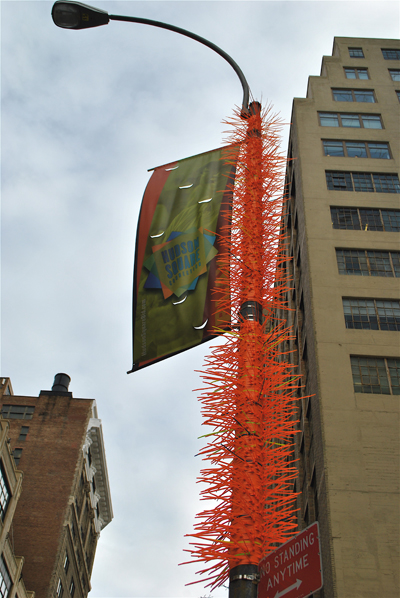 [/media-credit]
[/media-credit]
- The nine light poles in the urban plaza next to the Trump SoHo Hotel showcase the Flaming Cacti produced by the art collective Animus.
BY JOHN BAYLES | The typical street decorations this time of year usually consist of illuminated, twinkling stars hoisted atop a street light or Christmas trees strategically placed along sidewalks. But for Hudson Square, typical just isn’t good enough.
This holiday season, the Hudson Square Connection, the neighborhood’s Business Improvement District, decided to think outside of the box. Instead of the traditional décor, the B.I.D. decided upon something less ordinary: flaming cacti.
The origin of the cacti can be traced back to a Request for Proposal issued by the city’s Dept. of Transportation in 2008; part of the requirement to submit an application was the promise to utilize property owned by the D.O.T. Preston Dane and his partners at the art collective which goes by the name, Animus, received approval in 2009 for their idea to convert ordinary street lights into structural art. However, they were initially told the funds were not yet available for their project.
“The lampposts were an idea that just popped into my head,” said Dane. “We didn’t have any money. Our art is born out of thinking in terms of how to get the biggest bang for the buck.”
Animus’ first art project was the Animus Arbor, which appeared at the 2008 Burning Man Festival in Nevada. It was a gigantic weeping willow tree made solely out of glowing strands of light.
“The word ‘animus’ comes from the Latin root for spirit or animating force,” said Dane. “We saw it as the spirit of the tree.” In August of last year the art group received the go ahead from the D.O.T. and quickly created the first flaming cacti installation at Astor Place in the East Village.
The flaming cacti that now line the streets in Hudson Square and inhabit the urban plaza next to the Trump SoHo Hotel could similarly be seen as the “spirit” that defines the neighborhood in which they exist.
“The idea was to try and capture the creativity that is here in Hudson Square,” said Ellen Baer, president of the Hudson Square Connection. “When I saw them at Astor Place, my first impression was this would be a cool thing to expand on. I thought, it’s consistent with the theme and vibe of Hudson Square.”
One of the B.I.D.’s main goals, since its inception, has been analyzing and improving the area’s streetscape. Baer said public art is essential when it comes to realizing that goal.
“This is laying the foundation for public art’s role in our streetscape,” said Baer.
Constructing the flaming cacti was a two-part process, said Dane. In total, the 15 street lamps and the 9 light poles in the urban plaza next to the Trump SoHo contain a total of 52,000 zip ties.
“The process involves making sure every zip tie is inked into the next one,” said Dane. “We feed them into each other to make one, long strand.”
That part of the process was done off-site over one weekend, in which, according to Dane, each of the 52,000 zip ties were touched by hand at least twice. Twenty-five volunteers helped Animus in the first phase of the project.
The second phase involved actually wrapping the lampposts with the zip ties, which happened on the weekend after Thanksgiving and was done with the help of 17 volunteers.
“For each pole, it took two or three people between four [and] five hours to wrap,” said Dane.
The last cactus was completed around 8:30 p.m. on that Sunday.
“In the end, it was a magical feeling just in terms of the dedication that was involved,” said Dane.
Currently the cacti are set to remain in tact only throughout January, but Dane is optimistic.

“My experience with public art, is that no one is in a big hurry to take down something that is making the neighborhood more beautiful,” said Dane, who added that he hopes there’s a “double delight” involved for the passer-by who sees the pieces of art for the first time.
As for the colors of the cacti, which range from bright orange to bright blue and green, Baer said the B.I.D. did consult with Animus.
“I suppose we could’ve selected traditional holiday colors,” said Baer. “We wanted to focus on colors that would bring joy. We’re always thinking of ways to let people enjoy their space.”
“I hope people are pleasantly startled,” said Dane. “From afar, one experience is having people ask, ‘What is that?’ and then upon approach the viewer sees another layer.”
Dane did mention however that some people instinctively object to the cacti, but only because they aren’t completely educated.
“A lot of people look at it and say, ‘What a waste of zip ties,’” he remarked. “They look at it and think we’ve bound each tie to the pole. But the way we do it actually allows us to recycle each tie. They don’t all end up in the dump.”






































